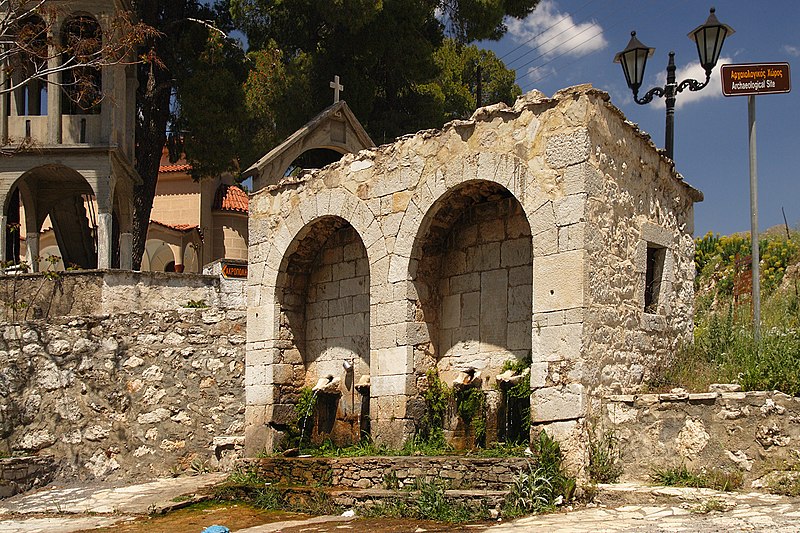File:Nestani-Fountain Peloponnese Greece.jpg
From Wikimedia Commons, the free media repository
Jump to navigation
Jump to search

Size of this preview: 800 × 533 pixels. Other resolutions: 320 × 213 pixels | 640 × 427 pixels | 1,024 × 683 pixels | 1,280 × 853 pixels | 1,800 × 1,200 pixels.
Original file (1,800 × 1,200 pixels, file size: 2.5 MB, MIME type: image/jpeg)
File information
Structured data
Captions
Captions
Add a one-line explanation of what this file represents
Summary
[edit]| DescriptionNestani-Fountain Peloponnese Greece.jpg |
Ελληνικά: Φιλίππειος Κρήνη. Δημόσια βρύση στην Νεστάνη. Η πέτρινη βρύση με τα τέσσερα “στόματα” της ένναι κομψό παράδειγμα της παραδοσιακής καλλιτεχνικής πέτρας. Η κρήνη αποτελεί σημαντικό στοιχείο της πολιτηστικής ταυτότητας του χωριού. Η κρήνη έναι στη μνήμη του Φιλππου ΙΙ της Μακεδονίας. Ο Φίλιππ έχτισε τη βάση του κοντά στην πηγή δτην Νεστανε το 338 π.Χ. English: Fountain of drinking water at Nestani (Νεστάνη Αρκαδιας), Peloponnese. The fountain is a monument of tradition of the historical legend of “Philipps Fountain” (Greek: Φιλίππειος Κρήνη) in memory of the famous ancient King Philip II of Macedon, of whom Pausanias (110-180 AD) writes in his famous “Description of Greece”, that he camped here in 338 BC (see ancient site Nestane). The cool, crystalline clear spring water flows out from faucets in a styled stone niche. In this way or in an artificially framed wall there are similar fountains in many Greek villages. The fountain and its environment served as social meeting point until decentral water supply into all houses was established. These premises are well kept and even today, maintained as an element of cultural identity of a village. Deutsch: Gedenkbrunnen zu dem historisch verbürgten Brunnen von Philipp II von Makedonien (Name des Brunnens in Griechisch: Φιλίππειος Κρήνη). Der gepflegte, Wasser spendende, Brunnen, der früher als Trinkwasserbrunnen diente, steht im Dorf Nestani (Νεστάνη Αρκαδιας), Peloponnes, hier direkt neben dem Kirchen- und Friedhofsbereich. Im klassischen Griechenland waren Quellen heilige Stellen. In vielen griechischen Dörfern sind traditionelle Brunnen wie der in Nestani die Stelle, an der man sich traf oder versammelte, solange es keine dezentrale Wasserversorgung gab (meist bis Ende des 19. Jahrhunderts). Das kühle Quellwasser wird aus immer noch laufenden, früher eigens errichteten steinernen Nischen und aus Spendern in Mauern dargeboten. Die Brunnen dienen vielfach als ein wichtiges Symbol kultureller Identität in griechischen Dörfern. |
| Date | |
| Source | Own work |
| Author | ulrichstill |
Licensing
[edit]This file is licensed under the Creative Commons Attribution-Share Alike 3.0 Germany license.
- You are free:
- to share – to copy, distribute and transmit the work
- to remix – to adapt the work
- Under the following conditions:
- attribution – You must give appropriate credit, provide a link to the license, and indicate if changes were made. You may do so in any reasonable manner, but not in any way that suggests the licensor endorses you or your use.
- share alike – If you remix, transform, or build upon the material, you must distribute your contributions under the same or compatible license as the original.

File history
Click on a date/time to view the file as it appeared at that time.
| Date/Time | Thumbnail | Dimensions | User | Comment | |
|---|---|---|---|---|---|
| current | 14:09, 31 August 2019 |  | 1,800 × 1,200 (2.5 MB) | Ulrichstill (talk | contribs) | User created page with UploadWizard |
You cannot overwrite this file.
File usage on Commons
There are no pages that use this file.
File usage on other wikis
The following other wikis use this file:
- Usage on de.wikipedia.org
- Usage on en.wikipedia.org
- Usage on fi.wikipedia.org
Metadata
This file contains additional information such as Exif metadata which may have been added by the digital camera, scanner, or software program used to create or digitize it. If the file has been modified from its original state, some details such as the timestamp may not fully reflect those of the original file. The timestamp is only as accurate as the clock in the camera, and it may be completely wrong.
| Image title |
|
|---|---|
| Camera manufacturer | Canon |
| Camera model | Canon EOS 350D DIGITAL |
| Author | allwiki@ulrich-tichy.de |
| Copyright holder |
|
| Exposure time | 1/160 sec (0.00625) |
| F-number | f/9 |
| ISO speed rating | 100 |
| Date and time of data generation | 12:19, 29 April 2007 |
| Lens focal length | 22 mm |
| Online copyright statement | https://commons.wikimedia.org/wiki/Fle:Nestani-Fountain_Peloponnese_Greece.jpg |
| Width | 3,456 px |
| Height | 2,304 px |
| Compression scheme | LZW |
| Pixel composition | RGB |
| Orientation | Normal |
| Number of components | 9 |
| Horizontal resolution | 72 dpi |
| Vertical resolution | 72 dpi |
| Data arrangement | chunky format |
| Software used | Adobe Photoshop CS5 Windows |
| File change date and time | 19:22, 28 July 2019 |
| Exif version | 2.21 |
| Date and time of digitizing | 12:19, 29 April 2007 |
| APEX shutter speed | 7.3219299316406 |
| APEX aperture | 6.33984375 |
| APEX exposure bias | −0.66666666666667 |
| Flash | Flash did not fire, compulsory flash suppression |
| Supported Flashpix version | 1 |
| Color space | sRGB |
| Focal plane X resolution | 3,954.2333984375 |
| Focal plane Y resolution | 3,958.7629394531 |
| Focal plane resolution unit | inches |
| Custom image processing | Normal process |
| Exposure mode | Auto bracket |
| White balance | Auto white balance |
| Scene capture type | Standard |
| Rating (out of 5) | 0 |
| Date metadata was last modified | 21:22, 28 July 2019 |
| Unique ID of original document | xmp.did:A565224114A7E9118E70ED8CC6E5D0C2 |
| Copyright status | Copyright status not set |